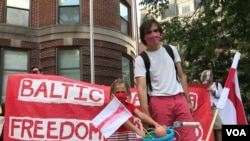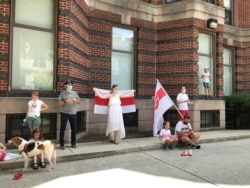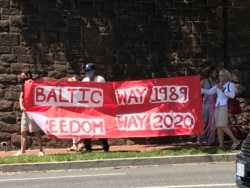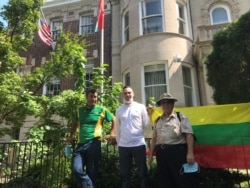Sundays for the Barysevich family are usually a time to catch up on chores and take their two young children to nearby parks and playgrounds. But just weeks after a disputed election in Yauheni Barysevich’s Belarusian homeland, this past Sunday was a time to protest.
“The last two weeks have been very different for our family and every Belarusian around the world,” he told VOA.
Shortly after breakfast, he set out on foot with his 5-year-old daughter, Lauren, pedaling her bicycle alongside, a big red-and-white Belarusian flag streaming from the back of it.
“My wife sewed this flag back in 2006,” Barysevich said, recalling that the now-familiar symbol of protest could not be purchased in the United States at that time. “I have taken it to every Belarusian event in the U.S. It has traveled with me to different states. And now my children know about it and what it signifies.”
Barysevich came to the United States from Belarus in 2004 and met his Russian-born wife a year later. The pair, now in their 30s, both work in the IT industry in the Washington area.
Barysevich said the march was much more than just a Sunday outing for young Lauren.
“This is an important time for Belarus, and I want my daughter to remember it and feel that she was a part of it,” he said.
It took Barysevich and Lauren an hour to walk and bike the 3 miles from their home to the Lithuanian embassy, where several hundred people had gathered.
After brief remarks, the crowd formed a line in the manner of the “human chain” created by residents of the Baltic states to protest Soviet rule in 1989. They then set off through the midday August heat along 16th Street NW toward the embassy of Belarus.
The marchers carried banners saying, “Free Belarus” and “Baltic Way 1989; Freedom Way 2020.” Many passing drivers honked their horns in support.
Among the marchers was Roman Vasiliuk, who said he was 18 when he took part in demonstrations in his native Belarus in 2006. Since coming to the United States 14 years ago as a student, he has continued demonstrating for Belarus’ freedom.
“Americans do what they can,” but ultimately it is the job of the Belarusian people to bring about change back home, he said, adding that continuous demonstrations and continuous pressure will be crucial.
Aleksas Radzius, who drove from Baltimore to Washington to join the protest, said he makes a point of participating in all of the protests aimed at overthrowing dictators.
“I was here when [the Baltic states] gained their independence,” said Radzius, who was born in Lithuania and came to America as a 6-year-old in 1950.
History in the making
The mostly Eastern European marchers were joined by a number of Americans, including Kurt Volker, a former U.S. ambassador to NATO who also served as a special representative on Ukraine negotiations.
Explaining that he was there as a private citizen, Volker told VOA that years from now, all the families that had brought their children to the event would remember the day.
Volker said he was there, along with other Washingtonians, to let the protesting people of Belarus know that “they’re not alone,” and that there should be no use of force against the peaceful protesters as events unfold there.
Dovydas Spokauskas, the deputy chief of mission at the embassy of Lithuania, explained the significance of the human chain formed at the start of Sunday’s protest.
“Thirty-one years ago, tens of thousands of Lithuanians, Estonians and Latvians went from Vilnius to Tallinn and formed a life chain. That was our way of saying to the Soviet Union that it’s enough, freedom is important for us, nobody was to tell us what to do any more.
“We feel that today, it’s the Belarusians who’re telling us the same thing. That’s why no Lithuanian can stay silent or stay idle.”
Spokauskas was 8 years old in 1989 when he and his parents took their positions in the line.










